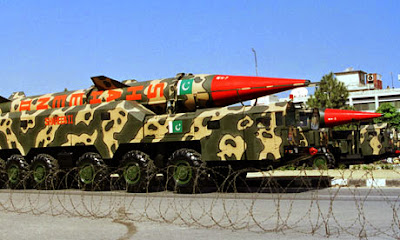Defence News: Pakistan successfully tested an intermediate-range ballistic missile
today with an impact point in the Persian Gulf. The newly tested version
of the Shaheen-II ballistic missile, which is roughly equivalent to the
US's Pershing II missiles, can carry either conventional or nuclear
warheads according to ISPR, the Pakistani army's public relations arm.
The announcement seems to confirm expert analysis
that the country is aiming to build long-range delivery systems for
tactical nuclear weapons - smaller warheads built for use in a
battlefield or active combat scenario, rather than for strikes on cities
or infrastructure.
Addressing scientists, engineers, and
military officers viewing the test site, lieutenant general Zubair
Mahmood Hayat still reiterated Pakistan's stance that the goal of its
strides in ballistic capability is deterrence - presumably against any
rash military action by India, with which Pakistan has a number of
outstanding territorial and security-related disputes.
Pakistani
news media put the range of the Shaheen-II at 1,500 kilometers, though
the Federation of American Scientists estimates it may be able to travel
2,000 kilometers or more depending on its payload. One Indian
television news program included a map showing the several India's cities that fall within the missile's now-proven range. The test is the latest development in a long-running arms race between Pakistan and its neighbor.
In 1999 Pakistan tested
a shorter-ranged Shaheen missile that was also capable of carrying
nuclear weapons. After that test, Pakistan's officials cited a concern
for preserving "strategic balance in south Asia" - an objective that has
India, Pakistan's larger, more populous, more powerful, and also
nuclear-armed rival, squarely in mind.
The missile program has
established that strategic balance with India, Arif Rafiq, a researcher
at the Middle East Institute, told Business Insider in September.
"Since
India and Pakistan tested nuclear weapons in 1998, there has been a
greater level of restraint in terms of the behavior of both countries
when it comes to war," Rafiq said. "But at the same time they also taken
great measures to build up their nuclear arsenal and further develop or
strengthen or diversify their launch capability."
While nuclear development continues, India and Pakistan have become the world's first and third largest arms importer.






















